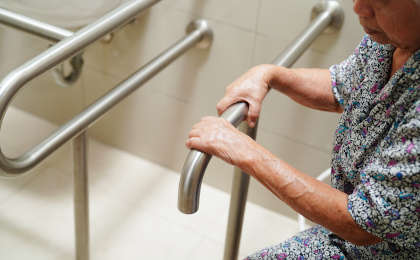While growing older presents unique challenges, it also offers unprecedented opportunities. With the progression of technology, today’s seniors have access to solutions that provide added comfort, safety, and independence. This guide explores technologies and methods that assist the senior community in determining whether “aging in place” is a viable solution that will allow them to remain within the familiar surroundings of their own homes.
No More Pill Sorting! Our Pharmacy Pre-sorts and Packages Your Pills
Understanding “Aging in Place”
The term “Aging in Place” refers to the choice of remaining in one’s home as one ages, rather than transitioning to an assisted living facility. Using supportive services and technology, seniors can adapt their existing homes to maintain and enhance their independence.
Five Technologies and Solutions for Aging in Place
1. Medical Alert Systems: Essential for Prompt Assistance
Medical alert systems are becoming indispensable for many seniors. They provide an immediate connection to emergency services or caregivers when required, ensuring rapid response during critical moments.
Types of Medical Alert Systems:
- Wearable Devices: Devices like the Medical Guardian, Life Alert, and Apple Smartwatch are designed to be worn as pendants, wristbands, or watches. They come with a simple button that, when pressed, signals for help. The main benefit of a wearable device is that since they are worn, they will be available to the individual wherever they go and are a great option for those with higher risk for falls or other injuries. One consideration is to ensure that batteries for these devices are regularly checked, especially when using Smartwatches or other devices with shorter battery life.
- Home-Based Systems: For those who primarily remain indoors, home-based systems offer centralized access. Strategically placed around the home, they ensure that assistance is always just a button press away. One consideration for home-based systems is that they require the user to both recall and have the physical ability to reach the system.
2. Medication Reminders: Ensuring Timely Health Management
As we advance in age, the complexity of medical routines can increase. Missing a dose or mistaking medications can have serious consequences. This is where technology can offer assistance.
Different Types of Medication Reminders:
- Medication Reminder Apps: For those familiar with smartphones, apps like Medisafe and CareZone send notifications reminding users about their medication schedule.
- Pill Organizers: Traditional yet effective, pill organizers compartmentalize medications based on timing, ensuring that the right pills are taken at the right time. This method requires that a knowledgeable individual can regularly organize medications as necessary.
- Smart Pill Dispensers: Advanced versions of pill organizers, these dispense the exact medication required at the touch of a button. Devices like MedReady, MedMinder, and Hero also offer auditory or visual alerts for doses. Again, these devices will require the technical support of an individual who can assist with regularly organizing the dispenser.
- MedBox: A great alternative for sorting pills and to simplifying your medication routine are pharmacies like MedBox, which can deliver your medications in presorted packets. These come in time-stamped, clearly labeled packets, and your only responsibility is to open the package and take the pills inside at the correct time. Best of all, the MedBox service is free and you only pay your existing copays. For more information about this service, visit the get started page on the MedBox site. In combination with a medication reminder app, MedBox may be one of the easiest and most reliable options (read more about medication reminder apps here).
3. Home Safety Enhancements: Building a Secure Living Environment

Physical safety is paramount. Falls are a common concern, and with age, the consequences of a fall can be severe. Technological solutions can assist in preventing these incidents and offering rapid response when they occur.
Types of Safety Enhancements:
- Fall Detection Sensors: These sensors can automatically detect a fall and alert emergency services or caregivers. While these are great, they may be cost-prohibitive for some.
- Home Modifications: From non-slip flooring to strategically placed grab bars, minor modifications can majorly boost home safety and can be done with minimal costs or renovations to a home. For those needing more comprehensive enhancements, elevators and stair lifts or integrating security systems with cameras and motion-activated lighting also improves overall safety.
MedBox: Never Sort Medications Again
4. Telehealth Services: Medical Consultations from Home
The modern age brings the doctor’s office into the living room. Telehealth services allow seniors to consult with medical professionals via phone calls, video chats, or secure messaging. This not only eliminates the need for frequent physical visits but also ensures timely medical intervention. One key benefit of Telehealth is remote health monitoring. Devices — including many wearable devices — can now regularly monitor vital parameters such as blood glucose levels, blood pressure, and heart rate. This data is sent in real-time to healthcare providers for immediate analysis and feedback. Although these data can be useful for regular monitoring of vital signs, it is important to understand that most at-home devices do not measure vital parameters with the accuracy of those done with medical health professionals, so regular on-site visits with your doctor are still required.
5. Mobility Aids: Enhancing Movement and Stability
For many, age can bring challenges related to mobility. Technology and design advancements in mobility aids provide solutions tailored to individual needs.
Types of Mobility Aids:
- Automated Wheelchairs and Mobility Scooters: For those requiring comprehensive mobility assistance.
- Walkers, Canes, and Crutches: For individuals seeking stability and support while walking.
In conclusion, as we navigate through the golden years, embracing these solutions and technologies can significantly enhance our quality of life. They act as tools that allow us to maintain our cherished independence, ensuring that we continue to thrive in the comfort and familiarity of our own homes.


